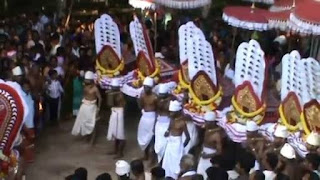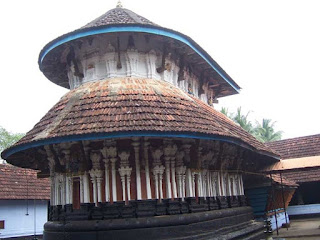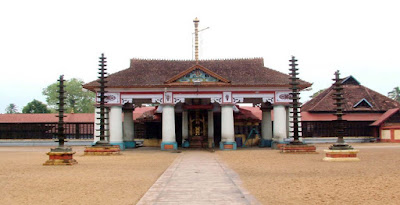As per Indian Vastu (Ancient Indian Architectural Science) facing south direction is not advisable. Usually, those who believe in Vastu will never construct houses facing the south. In such a scenario, you will be shocked to know about a temple in Kerala which is south facing.
Chinakkathoor Devi Temple, at Palappuram about 5 KM away from Ottappalam in the Palakkad district of Kerala is a south-facing temple dedicated to Goddess Devi. There are two shrines in this temple premises known as Melekkavu (Upper Shrine) and Thazhekkavu (Lower Shrine). The deity in the lower shrine is believed to be self-originated or Swayambhoo. The rituals at the upper shrine are being performed by the members of the Kulangara Nair family and the same in the lower shrine is by Brahmin Namboodiris.
 |
| Deities of Chinakkathoor lower shrine (left) and upper shrine(right |
Another interesting feature of this temple is that the annual temple festival begins with the screaming of devotees. Devotees in large numbers will gather around the flag mast of the temple and started screaming “Ayyo…..” Amidst the screaming, the chief priest will raise the temple flag announcing the beginning of the temple festival. The reason behind this totally strange ritual is related to the legend of the temple which goes to the period of Ramayana.
Lord Rama and Lakshamana reached Thirunelli on their way to Sri Lanka. Tired of walking all the way, Lord Rama asked Dharma Sastha and Goddess Devi who were accompanying him to find an ideal place to take rest. Both of them went in search of a place but did not return even after a long time. Lord Rama and his brother Lakshamana went in search of Devi and Dharmasastha.
Lord Rama became furious seeing both of them taking rest at a serene place at Vilwadri or Thiruvilwamala. He pushed Dharmasastha and sastha fell in a pit nearby. Even now the Sastha idol at Thiruvillwamala temple is in a pit and is called “Kundilayyappan”, Sastha or Ayyappan in a pit in the local language Malayalam.
Then Lord Rama slapped Goddess Devi on her face. With heavy pain, she screamed “Ayyo…” and ran away from there. She reached Palappuram and sat there. The screaming at the beginning of the festival is meant for commemorating this incident.
The annual temple festival is very famous in the state of Kerala and is known as “Chinakkathoor Pooram”. There is a legend behind this festival which also narrates how the temple became south faced.
Earlier, the idol in the temple was facing North direction. On those days, the Palappuram was under the regime of Zamorins or Samoodiris of Calicut. Kerala was divided into several feudal kingdoms on those days and they all were indulged in fighting with each other. Once, Samoodiri was moving southwards to fight a war with the King of the princely state of Cochin.
When he reached Palappuram, his palanquin bearers stopped moving. Although the tried their level best they could not move even an inch and stopped there as if their feet are chained. King alighted from the palanquin and enquired some locals about the reason. They told the king that he is on the backside of the Chinakkathoor Devi Temple and probably it is because of the divine power he is not able to move ahead.
King moved towards the temple and asked who is sitting there. Goddess Devi, who was sitting north faced turned back towards South to show her face to the king and told him that she was Kali. King worshiped her with great devotion and offered many offerings. Since then, the Devi is sitting facing south. King asked his subjects who gathered there to celebrate that occasion every year as a festival and thus started Chinakkathoor Pooram.

























